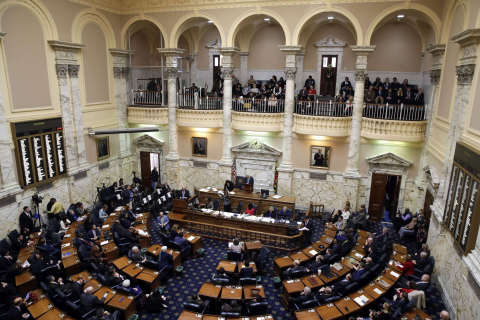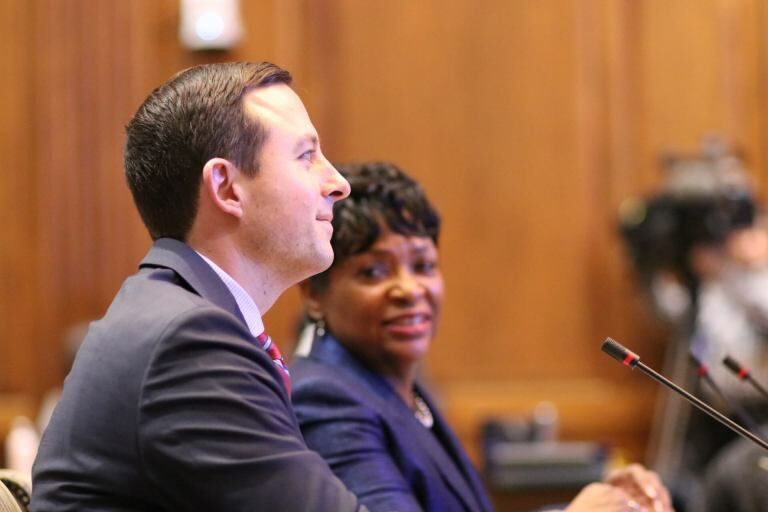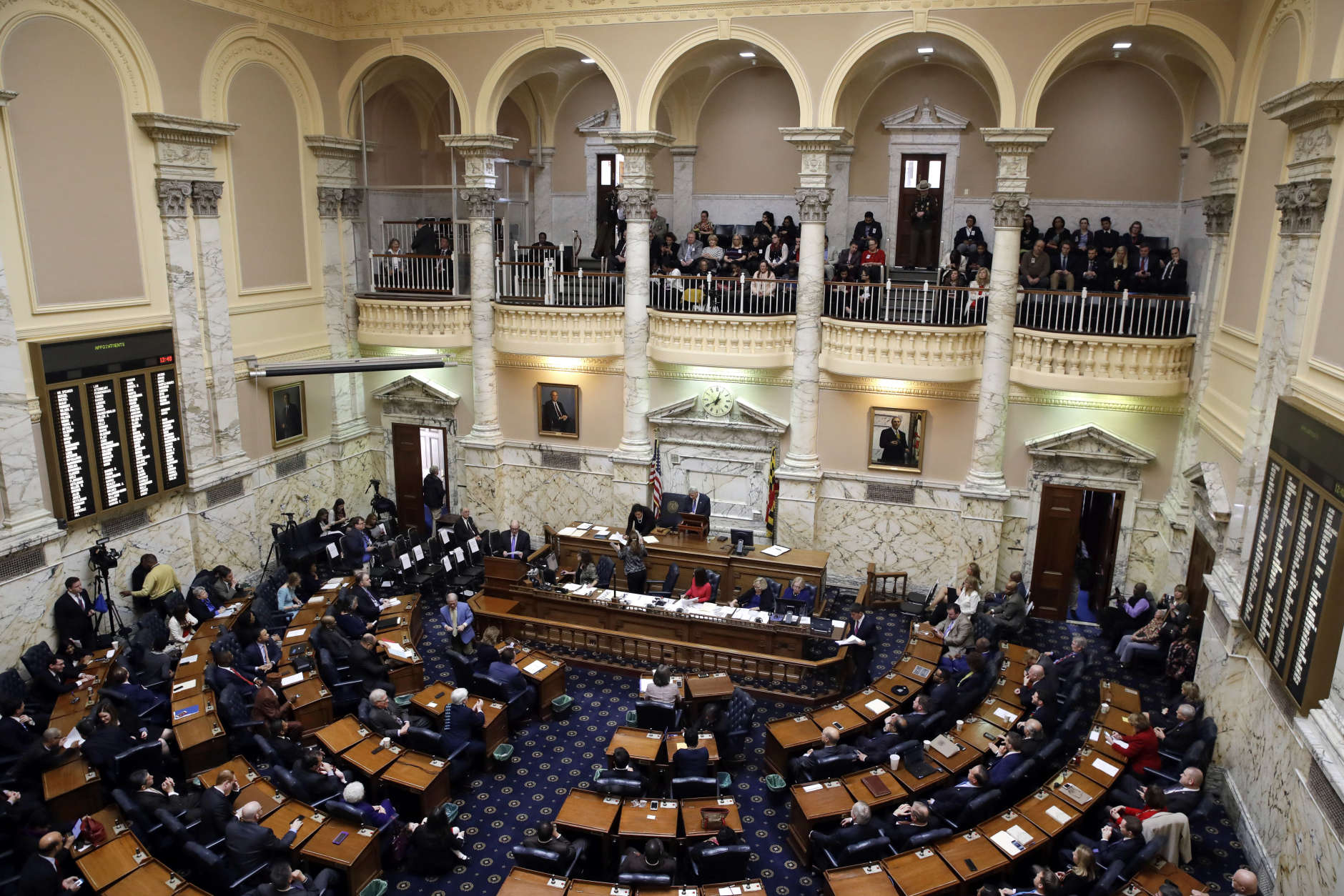This article was republished with permission from WTOP’s news partners at Maryland Matters. Sign up for Maryland Matters’ free email subscription today.

This content was republished with permission from WTOP’s news partners at Maryland Matters. Sign up for Maryland Matters’ free email subscription today.
Hundreds of people filled hearing rooms and rallied in Annapolis on Monday as the General Assembly took the unusual step of convening a joint hearing of four House and Senate committees, which, in the next seven weeks, will determine the fate of a three-year multibillion-dollar public school reform effort.
Advocates say recommendations of the Commission on Innovation and Excellence in Education have the potential to transform public schools in Maryland for future generations and correct wealth inequality throughout the state.
The four committees ― the House Appropriations and Ways and Means committees, and the Senate’s Budget and Taxation and Education, Health and Environmental Affairs committees ― heard testimony from 130 witnesses on Monday, in a hearing that lasted six hours.
House Speaker Adrienne A. Jones (D-Baltimore County) and Senate President Bill Ferguson (D-Baltimore City), who were both members of the commission before rising to their roles in legislative leadership, led off the hearing.

“Here’s what we know: the current system is not working,” Jones said. “We can’t be satisfied as policymakers until every child in every Zip code has the chance to succeed. Our most important and sacred duties as elected officials is that we leave a brighter future for our students.”
The legislation, called the “Blueprint for Maryland’s Future,” would expand pre-kindergarten programs and career education for high schoolers, increase pay and career opportunities for teachers, and increase state funding for schools with high concentrations of poverty.
The bill sets state funding requirements for newly proposed programs, but does not say how they should be paid for.
Gov. Lawrence J. Hogan Jr. (R) and legislative Republicans have expressed concern about the plan’s price tag.
Over the weekend, Republican leaders in the House of Delegates sought to delay the hearing by 48 hours as they waited for a Department of Legislative Services fiscal analysis.
According to the new fiscal note, available Monday morning, state aid to public schools is expected to increase by $2.6 billion annually by 2030; counties would be expected to collectively pay $1.3 billion more annually by 2030.
Jones stressed that the first three years of the bill are already covered.
Ferguson acknowledged that lawmakers will have to consider additional revenue options in the future, with separate revenue-generating bills under consideration this year.
“It’s going to cost more than we are spending today. That is a fact and a reality and something we have to own up to,” Ferguson said. “I believe that what we see in front of us is not only an investment in the short term, it is a long-term investment that will reap long-term rewards. Not just in our educational outcomes, but in our economic productivity moving forward.”
Here’s a quick glance at the bill’s primary focus areas, with some of the testimony from Monday’s mega-hearing:
Policy Area 1: Pre-kindergarten access
What’s proposed: Kirwan Commissioners want to expand pre-kindergarten access by creating a public-private model to add pre-kindergarten slots through a publicly funded system. The bill would create a state funding program that provides counties with a per-child payment for each kindergarten slot created in a public school or through a contract with a private provider. State funding for pre-kindergarten programs would ramp up over time, with the earliest focus on providing state funding to the low-income four-year-olds ― those from families earning 300 percent of the federal poverty level or less ― who want to enroll.
Why the commission likes it: Enrolling more students in pre-kindergarten can alleviate adverse childhood experiences and result in early intervention for learning difficulties. If more children receive interventions at a younger age, they’ll enter elementary and subsequent school levels more prepared, and the state’s special education population could decrease.
The cost: $529 million in state spending annually in 2030
Supporter: Montgomery County Executive Marc B. Elrich (D), a former elementary school teacher, said the provisions for pre-kindergarten were “critically important.”
What he had to say: “If kids don’t come to school ready to learn, they struggle and those struggles stay with them throughout their entire time in school. We know that if you start at a level playing field, you tend to stay level, which means you spend a lot less in remediation. I look at this legislation as a game-changer. I hope that this is the last generation of children that we have to put all these resources into. Because if we’re successful and their parents have better jobs and better opportunities, we’re not going to be dealing with the underlying issue of poverty to the extent that we’re dealing with it today.”
Policy Area 2: High-quality teachers
What’s proposed: The commission proposes an increase in salaries and advancement opportunities for teachers, as well as an increase in the number of teachers statewide. Teachers would reach different rungs on a proposed “career ladder,” including state certification, national certification and teachers could seek to be placed in leadership positions, either as part of a school’s administration or as mentors for other teachers. County school boards would be required to implement teacher salary increases over time, and all teacher salaries in the state are expected to be $60,000 or more by 2030. There also would be a focus on limiting teachers’ classroom duties to allow them more time for planning, mentoring and tutoring students in need.
Why the commission likes it: The commission’s goal is to increase the prestige associated with the teaching profession and make it a long-term career choice for high-achieving students. Commissioners also hoped to increase diversity in the teaching corps through an increase in funding for grants, teaching fellowships and loan repayment programs for those who teach in schools with high concentrations of poverty.
The cost: $168 million in state spending in fiscal 2030
Supporter: Maleeta Kitchen, Howard County Public Schools math teacher
What she had to say: “The Blueprint also addresses teacher prep and the need to hire more educators of color. It is important for students to see professional educators who look like them ― who look like me. Collaborating with higher education, especially our HBCU’s will hopefully bring more educators into the field of teaching.”
Seeking amendments: Diamonté Brown, of the Baltimore Teachers Union, said the proposed career ladders would restrict major salary increases to those teachers who become National Board Certified Teachers. She suggested an amendment to allow additional pathways for advancement in the career ladder.
What she had to say: “We the Baltimore Teachers Union understand that the National Board process can be a great professional development experience, and we are not opposed to it being used and incentivized as teachers hone their craft. We do have concerns about a process with no publicly available disaggregated data on passage rates by teacher race and by the poverty level of students served. Requiring National Board certification statewide could exacerbate equity concerns by making Baltimore City a place to teach where you’re less likely to advance financially and in the career ladder due to working in schools with concentrated poverty and trauma and less support for navigating the [National Board Certification] process.”
Policy Area 3: College and career readiness
What’s proposed: Under the reform plan, the goal is for students to reach a “college and career readiness” standard ― initially set as proficiency in 10th grade English and Algebra I ― by the end of their 10th grade year. Once that standard is met, those students would be eligible to enroll in college-level courses or in enhanced career education programs for the rest of their high school career. Students who don’t meet the standard in their 10th grade year would receive targeted interventions by teachers in an effort to get them to the standard by graduation.
Why the commission likes it: An early focus on post-graduation skills could allow students to graduate high school with career certificates or associate degrees, increasing wealth and success as adults. As an incentive, counties would receive a grant each year based on the percentage of students who meet the college and career readiness standard. The bill also includes a $500,000 study to determine if Maryland’s current career and college readiness standards are high enough.
The cost: $26 million in state spending annually by fiscal year 2030
Supporter: Brigette Dumais, executive director of the Maryland Workforce Alliance, expressed support for an increased focus on career and technical education programs.
What she had to say: “The increasing cost of college and the student debt crisis have made higher education a barrier to economic opportunity. Instituting robust CTE with paid on-the-job training would allow students to earn as they learn. Through the apprenticeship model, students receive both free college credits and a paycheck, carving a path to debt-free college. Additionally, CTE students will graduate high school with an industry-recognized credential, allowing them to immediately enter the well-paid workforce if they prefer not to go to college.”
Policy Area 4: More resources for at-risk children
What’s proposed: The commission wants to direct additional funding to students who attend schools with higher concentrations of poverty. The bill proposes annual “concentration of poverty” grants to schools with high numbers of so-called “at-promise” students to hire a school-based health-care practitioner and provide other wellness programs. The $248,833 grants would be provided in fiscal year 2022 to schools with concentrations of poverty of 80% or higher; the grants would be gradually expanded to cover schools with 55% concentrations of poverty by 2027.
Why the commission likes it: While all students who live in poverty may face hardships in school, the commission believes that those burdens are compounded when faced by the majority or nearly all students in a school. Other student groups targeted for increased funding in the bill include students learning English, those enrolled in special education programs, and “struggling learners” with low scores on standardized tests.
The cost: In 2030, the state’s annual spending would increase by $692 million for concentration of poverty grants, $182 million for special education, and $57 million to support students learning English.
Supporter: Wes Moore, CEO of antipoverty nonprofit Robin Hood and New York Times best-selling author
What he had to say: Moore asked lawmakers to “place an equity lens” on the state’s education funding formula. “I’m asking that you not tell our most vulnerable and our most systemically underserved communities to pay for their own poverty….But communities with the greatest need for these reforms are being asked to pay the most to get services desperately needed in every school and in every community, and that’s not fair.”
Policy Area 5: Implementation and accountability
What’s proposed: The bill establishes a seven-member Accountability and Implementation Board appointed jointly by the governor, Senate president and House speaker. The board would develop a statewide comprehensive implementation plan to guide reforms and would also approve county-level implementation plans. The board would have the power to withhold 25% of new state funding from counties each fiscal year until the board approves of a county’s progress toward implementing reforms.
The cost: $3.9 million in fiscal year 2030 for the accountability board and expert review teams that will travel the state to determine whether reforms are being successfully implemented in individual schools.
Testifying: Warner I. Sumpter, president of the Maryland State Board of Education
What he had to say: The state board is enthusiastic about the Blueprint proposal overall, but has “significant concerns” with the proposed accountability board. “The existing structures of the state government are the best mechanisms to provide the necessary governance and accountability sought,” Sumpter said. “…Under the oversight of the state board, the Maryland Department of Education has the structure, expertise and experience in place to carry out the responsibilities and charges outlined in this legislation.” He asked the committees to consider an amendment to put the state board in charge of accountability measures.
Maryland Matters reporter Hannah Gaskill contributed to this story.








